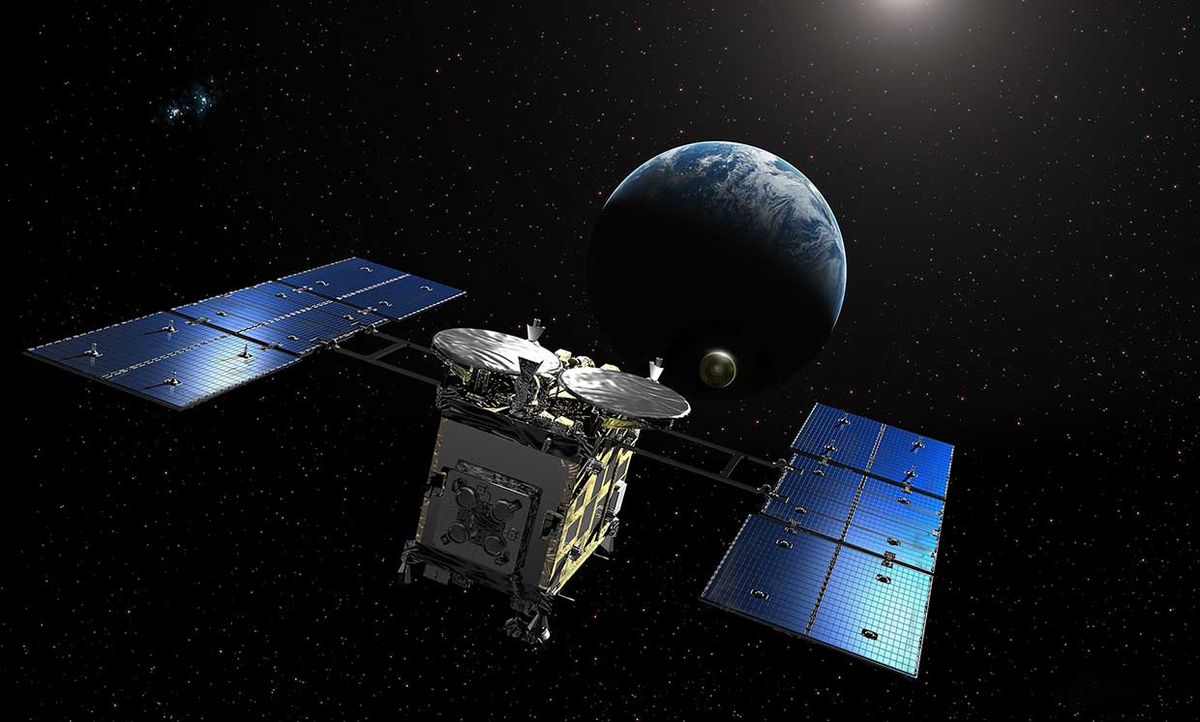Okaerinasai is Japanese for “Welcome back.” It’s a word everyone at the Japan Aerospace Exploration Agency JAXA will be shouting together around 2 am Tokyo time on December 6, when a capsule ejected from the Hayabusa2 space probe is due to land in Woomera, South Australia, after a 5.2 billion kilometer round-trip.
The reentry capsule is expected to contain precious particles scooped from the rock-strewn surface and subsurface of Ryugu, a diamond-shape asteroid less than a kilometer in diameter. This difficult trick was pulled off as Ryugu traveled on its 16-month orbit around the sun between Earth and Mars. What’s more, Hayabusa2 was able to land twice on the spinning asteroid and complete a series of missions. Perhaps the most difficult and spectacular of these was using an impactor to form a crater on the asteroid for gathering particles from below its surface—one of a number of firsts in space exploration Hayabusa2 has achieved.
Providing all goes as planned, the capsule will separate from the spacecraft on December 5, some 220,000 km from Earth. After which Hayabusa2 will enter an escape trajectory to depart Earth and commence on an extension of its mission. So long as the craft is still operational and has 50 percent of its xenon fuel remaining to drive its ion thruster engines, JAXA has set it the goal of visiting and observing an asteroid of a type never explored before. If successful, Hayabusa2 will reach its target in 2031.
In a press briefing a week before the landing, the project’s mission manager Makoto Yoshikawa explained how a JAXA team, working with the Australian Space Agency, will locate and retrieve the capsule. Ground stations and an airplane flying above the clouds will triangulate the capsule fireball’s progress through the Earth’s atmosphere by measuring its light trail. Then, at an altitude of 10 km above the Earth, the capsule will deploy a parachute and land somewhere (depending on weather conditions) within a 100 km2 area of the Woomera desert.
Yoshikawa described how JAXA track and trace the capsule. Four marine radar units have been set up around the predicted landing area. Their fan-beam horizontal rotating antenna will track an umbrella made of radar-reflective-cloth attached to the top of the descending parachute. At the same time, a radio beacon in the capsule will begin signaling its location.
“A helicopter and a team on the ground will track the beacon’s signal that will continue transmitting after landing,” Yoshikawa added. “We’re also bringing drones to help us find it as quickly as possible.”
The capsule will be taken by helicopter to a quick-look facility established in the Woomera Prohibited Area. There, the instrument module and sealed containers holding the Ryugu samples will be removed, including any gas released by the particles, and stored and sealed in special containers and airlifted to Japan. The aim is to complete all this in less than 100 hours after the landing to minimize any risk of contamination.
Once at JAXA, the samples will be removed in a vacuum environment inside a cleanroom. Over the next two years, each particle will be analyzed, described, and curated, with some of the particles being sent to international organizations, including NASA, for further study.
In a separate press briefing in Australia on December 1, Masaki Fujimoto, a Deputy Director at JAXA, explained why the samples taken from Ryugu are so important. Earth, being relatively close to the sun, was created dry without much water present. Something must have brought the H2O here. Ryugu is a primordial asteroid born outside the inner solar system and is the kind of body that could have brought water and organic materials to our planet that enabled the creation of life.
Analysis of the collected samples, says Fujimoto, “could help answer the fundamental question of how our planet became habitable.”
He said that the asteroid samples gathered will likely amount to around one gram. “One gram may sound small to some of you,” said Fujimoto, “but for us, it is huge and enough to address the science questions we have in mind.”
Update (Dec. 6): JAXA confirmed the reentry capsule entered the Earth’s atmosphere at 2.28 a.m. Japan standard time on December 6. A helicopter searched for and located it in the Woomera desert at 4.47, then flew it to the quick look facility in the Woomera Prohibited Area, arriving just after 8 a.m. The JAXA recovery team is expected to extract any gas from the captured Ryugu samples. On its approach and orbit, beginning on December 5, Hayabusa2 performed several trajectory maneuvers to successfully depart Earth’s orbit and has now set out on its extended mission to observe an asteroid it hopes to visit in 2031.



